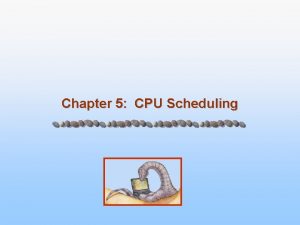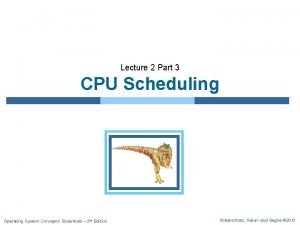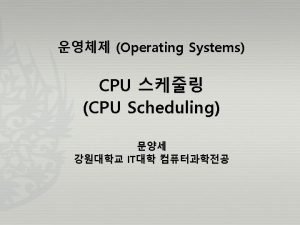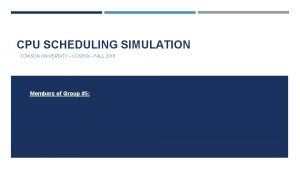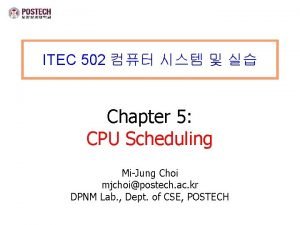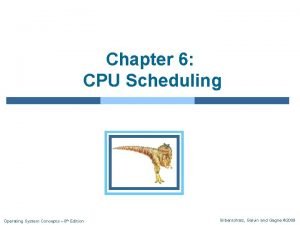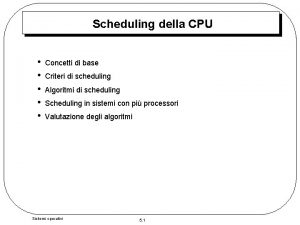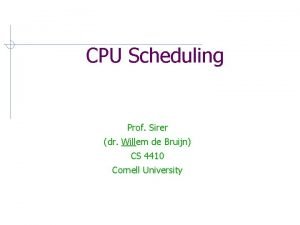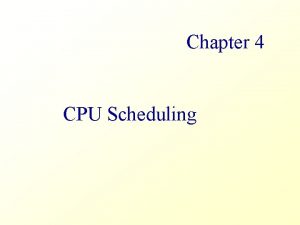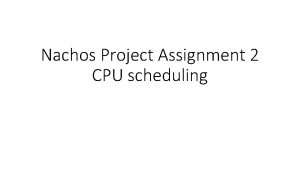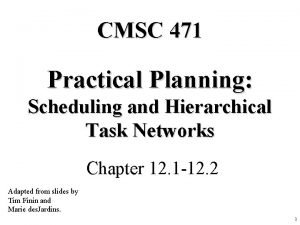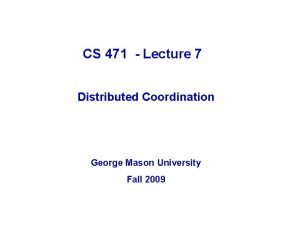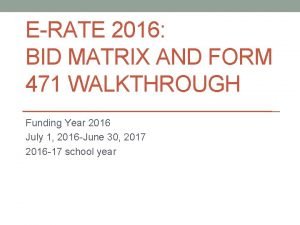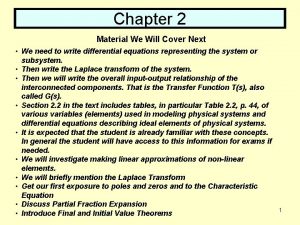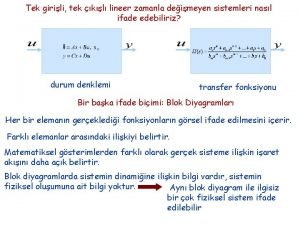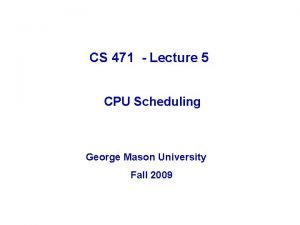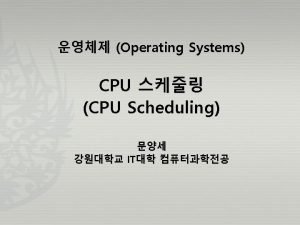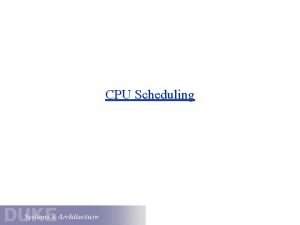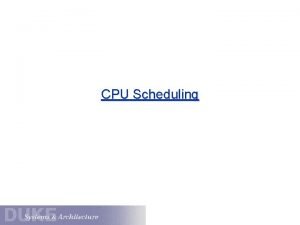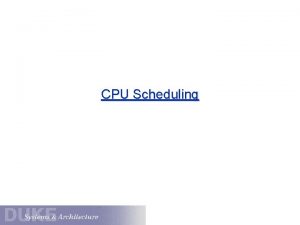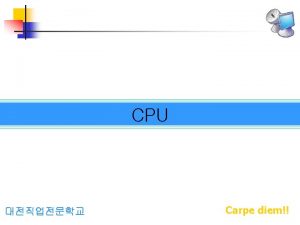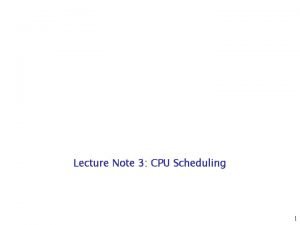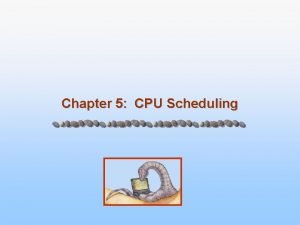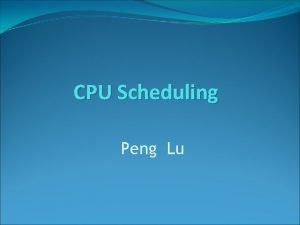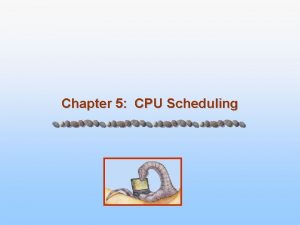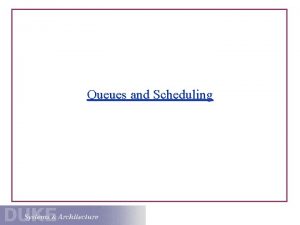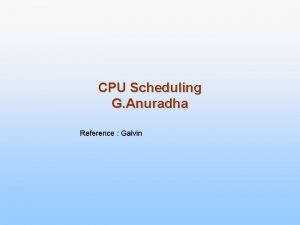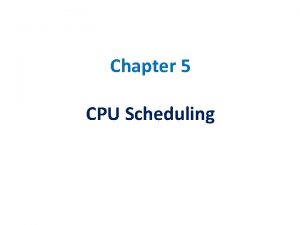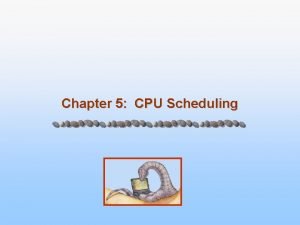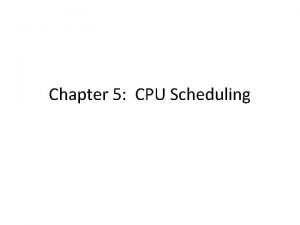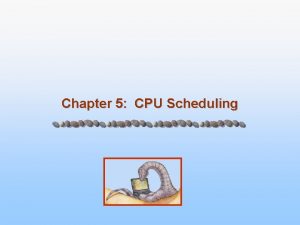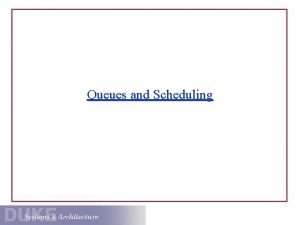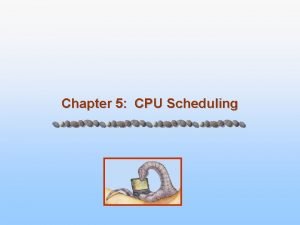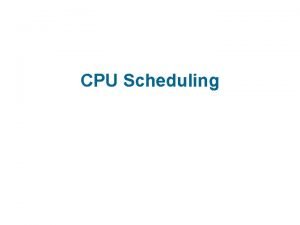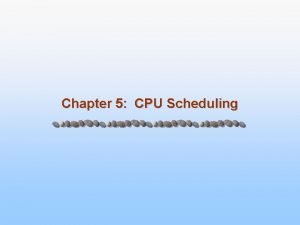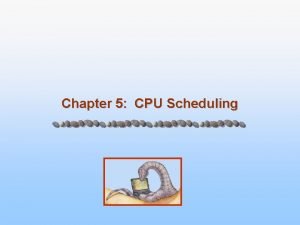CS 471 Lecture 5 CPU Scheduling George Mason


















































- Slides: 50

CS 471 - Lecture 5 CPU Scheduling George Mason University Fall 2009

CPU Scheduling § Basic Concepts § Scheduling Criteria § Scheduling Algorithms § • • • First-Come-First-Served Shortest-Job-First, Shortest-remaining-Time-First Priority Scheduling Round Robin Multi-level Queue Multi-level Feedback Queue Real-Time CPU Scheduling GMU – CS 571 5. 2

Basic Concepts § § During its lifetime, a process goes through a sequence of CPU and I/O bursts. In a multi-programmed computer system, multiple process compete for the CPU at a given time, to complete their current CPU bursts. GMU – CS 571 5. 3

Basic Concepts § The CPU scheduler (a. k. a. short-term scheduler) will select one of the processes in the ready queue for execution. § The CPU scheduler algorithm may have tremendous effects on the system performance • Interactive systems • Real-time systems § Dispatcher module gives control of the CPU to the process selected by the short-term scheduler; this involves: • switching context • switching to user mode • jumping to the proper location in the user program to restart that program GMU – CS 571 5. 4

When to Schedule? Under a simple process state transition model, CPU scheduler could be invoked at five different points: 1. When a process switches from the new state to the ready state. 2. When a process switches from the running state to the waiting state. 3. When a process switches from the running state to the ready state. 4. When a process switches from the waiting state to the ready state. 5. When a process terminates. Terminate New d Admit Exit Scheduler Dispatch Ready Running Timeout Event occurs Event wait Waiting GMU – CS 571 5. 5

Non-preemptive vs. Preemptive Scheduling § Under non-preemptive scheduling, each running process keeps the CPU until it completes or it switches to the waiting (blocked) state (points 2 and 5 from previous slides). § Under preemptive scheduling, a running process may be also forced to release the CPU even though it is neither completed nor blocked. • In time-sharing systems, when the running process • § reaches the end of its time quantum (slice) In general, whenever there is a change in the ready queue. Tradeoffs? GMU – CS 571 5. 6

Scheduling Criteria § Several criteria can be used to compare the performance of scheduling algorithms • CPU utilization – keep the CPU as busy as • • • GMU – CS 571 possible Throughput – # of processes that complete their execution per time unit Turnaround time – amount of time to execute a particular process Waiting time – amount of time a process has been waiting in the ready queue Response time – amount of time it takes from when a request was submitted until the first response is produced, not the complete output. Meeting the deadlines (real-time systems) 5. 7

Optimization Criteria § § § Maximize the CPU utilization Maximize throughput Minimize the (average) turnaround time Minimize the (average) waiting time Minimize the (average) response time Minimize variance § In the examples, we will assume • average waiting time is the performance measure • only one CPU burst (in milliseconds) per process GMU – CS 571 5. 8

First-Come, First-Served (FCFS) Scheduling § § Single FIFO ready queue No-preemptive • Not suitable for timesharing systems Simple to implement and understand Average waiting time dependant on the order processes enter the system GMU – CS 571 5. 9

First-Come, First-Served (FCFS) Scheduling § Process Burst Time P 1 24 P 2 3 P 3 3 Suppose that the processes arrive in the order: P 1 , P 2 , P 3 The Gantt Chart for the schedule: P 1 P 2 0 § § 24 Waiting time for P 1 = 0; P 2 = 24; P 3 = 27 Average waiting time: (0+24+27)/3 = 17 GMU – CS 571 5. 10 P 3 27 30

FCFS Scheduling (Cont. ) § Suppose that the processes arrive in the order P 2 , P 3 , P 1 § The Gantt chart for the schedule: P 2 0 § § § P 3 3 P 1 6 30 Waiting time for P 1 = 6; P 2 = 0; P 3 = 3 Average waiting time: (6 + 0 + 3)/3 = 3 Problems: • Convoy effect (short processes behind long processes) • Non-preemptive -- not suitable for time-sharing systems GMU – CS 571 5. 11

Shortest-Job-First (SJF) Scheduling § § Associate with each process the length of its next CPU burst. The CPU is assigned to the process with the smallest CPU burst (FCFS can be used to break ties). Two schemes: • nonpreemptive • preemptive – Also known as the § § Shortest-Remaining-Time-First (SRTF). Non-preemptive SJF is optimal if all the processes are ready simultaneously– gives minimum average waiting time for a given set of processes. SRTF is optimal if the processes may arrive at different times GMU – CS 571 5. 12

Example for Non-Preemptive SJF § Process P 1 P 2 P 3 P 4 Arrival Time 0. 0 2. 0 4. 0 5. 0 Burst Time 7 4 1 4 SJF (non-preemptive) P 1 0 § 3 7 At time 0, P 1 is the only process, so it gets the CPU and runs to completion GMU – CS 571 5. 13

Example for Non-Preemptive SJF § Process Arrival Time Burst Time P 1 0. 0 7 P 2 2. 0 4 P 3 4. 0 1 P 4 5. 0 4 Once P 1 has completed the queue now holds P 2, P 3 and P 4 P 1 § § P 3 P 2 P 4 0 3 7 8 12 16 P 3 gets the CPU first since it is the shortest. P 2 then P 4 get the CPU in turn (based on arrival time) Avg waittime = (0+8+7+12)/4 = 6. 75 GMU – CS 571 5. 14

Estimating the Length of Next CPU Burst § § § Problem with SJF: It is very difficult to know exactly the length of the next CPU burst. Idea: Based on the observations in the recent past, we can try to predict. Exponential averaging: nth CPU burst = tn; the average of all past bursts tn, using a weighting factor 0<=a<=1, the next CPU burst is: tn+1 = a tn + (1 - a) tn. GMU – CS 571 5. 15

Example for Preemptive SJF (SRTF) Process P 1 P 2 P 3 P 4 § § § Arrival Time 0. 0 2. 0 4. 0 5. 0 Burst Time 7 4 1 4 Time 0 – P 1 gets the CPU Ready = [(P 1, 7)] Time 2 – P 2 arrives – CPU has P 1 with time=5, Ready = [(P 2, 4)] – P 2 gets the CPU Time 4 – P 3 arrives – CPU has P 2 with time = 2, Ready = [(P 1, 5), (P 3, 1)] – P 3 gets the CPU P 1 GMU – CS 571 P 2 2 P 3 4 5 5. 16

Example for Preemptive SJF (SRTF) Process P 1 P 2 P 3 P 4 § § § Arrival Time 0. 0 2. 0 4. 0 5. 0 Burst Time 7 4 1 4 Time 5 – P 3 completes and P 4 arrives - Ready = [(P 1, 5), (P 2, 2), (P 4, 4)] – P 2 gets the CPU Time 7 – P 2 completes – Ready = [(P 1, 5), (P 4, 4)] – P 4 gets the CPU Time 11 – P 4 completes, P 1 gets the CPU P 1 GMU – CS 571 P 2 P 3 P 2 5 P 4 7 5. 17 P 1 11 16

Example for Preemptive SJF (SRTF) § Process P 1 P 2 P 3 P 4 Burst Time 7 4 1 4 SJF (preemptive) P 1 P 2 2 § Arrival Time 0. 0 2. 0 4. 0 5. 0 P 3 4 P 2 5 P 4 7 P 1 11 Average waiting time = (9 + 1 + 0 +2)/4 = 3 GMU – CS 571 5. 18 16

Priority-Based Scheduling § A priority number (integer) is associated with each process § The CPU is allocated to the process with the highest priority (smallest integer highest priority). • Preemptive • Non-preemptive § SJF is a priority scheme with the priority the remaining time. GMU – CS 571 5. 19

Example for Priority-based Scheduling Process P 1 P 2 P 3 P 4 P 5 P 2 P 1 P 5 1 GMU – CS 571 Burst Time 10 1 2 1 5 Priority 3 1 4 5 2 P 3 16 6 5. 20 P 4 18 19

Priority-Based Scheduling (Cont. ) § § § Problem: Indefinite Blocking (or Starvation) – low priority processes may never execute. One solution: Aging – as time progresses, increase the priority of the processes that wait in the system for a long time. Priority Assignment • Internal factors: timing constraints, memory • GMU – CS 571 requirements, the ratio of average I/O burst to average CPU burst…. External factors: Importance of the process, financial considerations, hierarchy among users… 5. 21

Round Robin (RR) Scheduling § § Each process gets a small unit of CPU time (time quantum). After this time has elapsed, the process is preempted and added to the end of the ready queue. Newly-arriving processes (and processes that complete their I/O bursts) are added to the end of the ready queue If there are n processes in the ready queue and the time quantum is q, then no process waits more than (n-1)q time units. Performance • q large FCFS • q small Processor Sharing (The system appears to the users as though each of the n processes has its own processor running at the (1/n)th of the speed of the real processor) GMU – CS 571 5. 22

Example for Round-Robin § Process P 1 P 2 P 3 P 4 The Gantt chart: (Time Quantum = 20) P 1 § § Burst Time 53 17 68 24 0 P 2 20 37 P 3 57 P 4 P 1 P 3 P 3 77 97 117 121 134 154 162 Average wait time = (81+20+94+97)/4 = 73 Typically, higher average turnaround time (amount of time to execute a particular process) than SJF, but better response time (amount of time it takes from when a request was submitted until the first response is produced). GMU – CS 571 5. 23

Example for Round-Robin § Process P 1 P 2 P 3 P 4 Burst Time 53 17 68 24 The Gantt chart: (Time Quantum = 30) P 1 0 P 2 30 47 P 3 77 P 4 P 1 P 3 101 124 154 162 § Average wait time = (71+30+94+77)/4 = 68 § When Time Quantum = 10 get average wait time = (91+40+94+77)/4 = 75. 5 GMU – CS 571 5. 24

Choosing a Time Quantum § § § The effect of quantum size on context-switching time must be carefully considered. The time quantum must be large with respect to the context-switch time Modern systems use quanta from 10 to 100 msec with context switch taking < 10 msec GMU – CS 571 5. 25

Turnaround Time and the Time Quantum Turnaround time also depends on the size of the time quantum GMU – CS 571 5. 26

Multilevel Queue § § Sometimes different processes can be partitioned into groups with different properties. Ready queue is partitioned into separate queues: Example, a queue foreground (interactive) and another for background (batch) processes; or: GMU – CS 571 5. 27

Multilevel Queue Scheduling § Each queue may have has its own scheduling algorithm: Round Robin, FCFS, SJF… § In addition, (meta-)scheduling must be done between the queues. • Fixed priority scheduling (i. e. serve first the queue • • GMU – CS 571 with highest priority). Problems? Time slice – each queue gets a certain amount of CPU time which it can schedule amongst its processes; for example, 50% of CPU time is used by the highest priority queue, 20% of CPU time to the second queue, and so on. . Also, need to specify which queue a process will be put to when it arrives to the system and/or when it starts a new CPU burst. 5. 28

Multilevel Feedback Queue § In a multi-level queue-scheduling algorithm, processes are permanently assigned to a queue. § Idea: Allow processes to move among various queues. § Examples • If a process in a queue dedicated to interactive • GMU – CS 571 processes consumes too much CPU time, it will be moved to a (lower-priority) queue. A process that waits too long in a lower-priority queue may be moved to a higher-priority queue. 5. 29

Example of Multilevel Feedback Queue § § § Three queues: • Q 0 – RR - time quantum 8 milliseconds • Q 1 – RR - time quantum 16 milliseconds • Q 2 – FCFS Qi has higher priority than Qi+1 Scheduling • A new job enters the queue Q 0. When it gains • GMU – CS 571 CPU, the job receives 8 milliseconds. If it does not finish in 8 milliseconds, the job is moved to the queue Q 1. In queue Q 1 the job receives 16 additional milliseconds. If it still does not complete, it is preempted and moved to the queue Q 2. 5. 30

Multilevel Feedback Queue GMU – CS 571 5. 31

Multilevel Feedback Queue § Multilevel feedback queue scheduler is defined by the following parameters: • number of queues • scheduling algorithms for each queue • method used to determine when to upgrade a • • § process method used to determine when to demote a process method used to determine which queue a process will enter when that process needs service The scheduler can be configured to match the requirements of a specific system. GMU – CS 571 5. 32

More on Scheduling § Scheduling on Symmetric Multiprocessors • Partitioned versus Global Scheduling • Processor Affinity (some remnants of a process may remain in one processor's state) • Load Balancing (push vs. pull) § Real OS examples (see text 5. 6) • Solaris • Windows XP • Linux § Algorithm Evaluation (5. 7) GMU – CS 571 5. 33

Scheduling Issues in Real-Time Systems § Timeliness is crucial § Important features of real-time operating systems • Preemptive kernels • Low latency • Preemptive, priority-based scheduling GMU – CS 571 5. 34

Non-preemptive vs. preemptive kernels § Non-preemptive kernels do not allow preemption of a process running in kernel mode • Serious drawback for real-time applications § Preemptive kernels allow preemption even in kernel mode • Insert safe preemption points in long-duration • GMU – CS 571 system calls Or, use synchronization mechanisms (e. g. mutex locks) to protect the kernel data structures against race conditions 5. 35

Minimizing Latency § Event latency is the amount of time that elapses between the occurrence of an event and the completion time of the service GMU – CS 571 5. 36

Interrupt Latency § Interrupt latency is the period of time from when an interrupt arrives at the CPU to when it is serviced. GMU – CS 571 5. 37

Dispatch Latency § Dispatch latency is the amount of time required for the scheduler to stop one process and start another. GMU – CS 571 5. 38

Dispatch Latency § Conflict (Cont. ) • Preemption of process running in kernel • Release by low-priority processes resources needed by high-priority process GMU – CS 571 5. 39

Minimizing latency § Bounding interrupt and dispatch latencies is crucial for hard real-time operating systems § What if a higher-priority process needs to read or modify the kernel data structures that are currently being accessed by a low-priority process? § Additional delays that may be caused by medium-priority processes § The priority inversion problem GMU – CS 571 5. 40

Hard Real-Time CPU Scheduling § Must make sure all the processes will meet their deadlines even under worst-case resource requirements § Typically requires preemptive, priority-based scheduling • How to assign priorities? § Most real-time processes are periodic in nature (i. e. require the CPU at constant intervals for a fixed time t) GMU – CS 571 5. 41

Hard Real-Time CPU Scheduling § § § Periodic processes require the CPU at specified intervals (periods) p is the duration of the period (the rate is 1/p) d is the relative deadline by when the process must be serviced (in many cases, equal to p) t is the processing time 0 <= t <= d <= p GMU – CS 571 5. 42

Priority Assignment § How to assign priorities to periodic real-time processes to meet all the deadlines? § If the priority assignment is such that the relative priorities of any two processes remain the same, then it is said to be a static priority assignment. § Consider two processes: • P 1 has the period p 1 = 50, processing time t 1 = 20 • P 2 has the period p 2 = 100, processing time t 2 = 35 GMU – CS 571 5. 43

The concept of utilization § The CPU utilization of a process is defined by the ratio of its worst-case processing time (CPU burst length) to its period § The total utilization of the real-time process set can be computed as Utot = (ti / pi) § Two processes: • P 1 has the period p 1 = 50, processing time t 1 = 20 • P 2 has the period p 2 = 100, processing time t 2 = 35 Utilization = 20/50 + 35/100 =. 75 utilization of the CPU – can we schedule them? ? GMU – CS 571 5. 44

Priority Assignment (Cont. ) § Two processes: • P 1 has the period p 1 = 50, processing time t 1 = 20 • P 2 has the period p 2 = 100, processing time t 2 = 35 § Give P 2 higher priority GMU – CS 571 5. 45

Priority Assignment (Cont. ) § Two processes: • P 1 has the period p 1 = 50, processing time t 1 = 20 • P 2 has the period p 2 = 100, processing time t 2 = 35 § Give P 1 higher priority GMU – CS 571 5. 46

Rate Monotonic Scheduling (RMS) § A static priority assignment scheme § Assign priorities inversely proportional to the period lengths § Priorities associated with a process remain fixed § RMS is optimal among all static priority assignment schemes: if it is not able to meet all the deadlines of a periodic process set, then no other static priority assignment can do it either. • This assumes the relative deadlines are equal to the periods! GMU – CS 571 5. 47

Rate Monotonic Scheduling (RMS) § The deadlines of a process set with n processes can be always met by RMS, if Utot ≤ n (21/n - 1) • For n = 1, the bound is 100% • For n = 2, the bound is 82. 8 % • For large n, the bound is ln 2 (69. 8 %) GMU – CS 571 5. 48

Rate Monotonic Scheduling (RMS) § When the utilization bound is exceeded, meeting the deadlines cannot be guaranteed § Consider two processes: • P 1 has the period p 1 = 50, processing time t 1 = 25 • P 2 has the period p 2 = 80, processing time t 2 = 35 • Utot = 0. 94 > 2 (21/2 – 1 ) GMU – CS 571 5. 49

Earliest Deadline First (EDF)Scheduling § § § Priorities are assigned according to absolute deadlines: the earlier the absolute deadline, the higher the priority. Dynamic priority assignment scheme Again, consider two processes: • P 1 has the period p 1 = 50, processing time t 1 = 25 • P 2 has the period p 2 = 80, processing time t 2 = 35 § EDF can achieve 100% CPU utilization while still guaranteeing all the deadlines GMU – CS 571 5. 50
 Cornelia wilbur
Cornelia wilbur Preeptive
Preeptive Turnaround time in os
Turnaround time in os Cpu i/o
Cpu i/o Cpu scheduling project
Cpu scheduling project Preemptive priority scheduling
Preemptive priority scheduling Sjf cpu scheduling
Sjf cpu scheduling Scheduling della cpu
Scheduling della cpu Sjf cpu scheduling
Sjf cpu scheduling In cpu scheduling the clock is of type
In cpu scheduling the clock is of type Cpu scheduling project
Cpu scheduling project Gantt chart fcfs
Gantt chart fcfs Mason life program
Mason life program George mason off campus housing
George mason off campus housing George mason anti federalist
George mason anti federalist Mason high motivation
Mason high motivation George mason university english language institute
George mason university english language institute George mason federalist or anti federalist
George mason federalist or anti federalist George mason university mha
George mason university mha George mason orientation
George mason orientation How to drop a class gmu
How to drop a class gmu Sjn scheduling
Sjn scheduling 01:640:244 lecture notes - lecture 15: plat, idah, farad
01:640:244 lecture notes - lecture 15: plat, idah, farad Cogulation cascade
Cogulation cascade Ee-471
Ee-471 Cmsc 471
Cmsc 471 Cmsc471
Cmsc471 Ece 471
Ece 471 Cse 471
Cse 471 Cmpt 471
Cmpt 471 Cse 471 asu
Cse 471 asu Cse 471
Cse 471 Asu cse 571
Asu cse 571 Cse 471
Cse 471 Cs 471 gmu
Cs 471 gmu Erate form 471
Erate form 471 King george vs george washington
King george vs george washington Venn diagram george washington and king george iii
Venn diagram george washington and king george iii Mason ndiaye
Mason ndiaye North mason little league
North mason little league Mason's gain rule
Mason's gain rule Legg mason breakpoints
Legg mason breakpoints Mason street church of christ
Mason street church of christ Ford pestel analysis
Ford pestel analysis Blok diyagramı
Blok diyagramı James neville mason
James neville mason Jane dunker
Jane dunker Mason moore jealous
Mason moore jealous Eavan miles mason
Eavan miles mason Herbert mason gilgamesh
Herbert mason gilgamesh Bricking mason evaporator
Bricking mason evaporator

